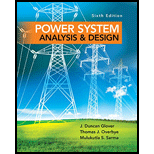
Concept explainers
Consider a long radial line terminated in its characteristic impedance
(a)
(b)
(c)
(d) The complex power gain,
(e) The real power efficiency,
Note: 1 refers to sending end and 2 refers to receiving end.
Want to see the full answer?
Check out a sample textbook solution
Chapter 5 Solutions
Power System Analysis and Design (MindTap Course List)
- A 3-phase transmission line, 160 km long, has the following constants : Resistance/phase/km = 0·2 Ω[263·574 kV ; 187·5 A]Reactance/phase/km = 0·3127 Ω Shunt admittance/phase/km = 1·875 × 10−6 SDetermine the sending end voltage and current by rigorous method when the line is delivering a load of 25 MVA at 0·8 p.f. lagging. The receiving end voltage is kept constant at 110 kVarrow_forwardA 3-phase, 50 Hz, 100 km transmission line has the following constants ;Resistance/phase/km = 0·1 ΩReactance/phase/km = 0·5 ΩSusceptance/phase/km = 10−5siemenIf the line supplies a load of 20 MW at 0·9 p.f. lagging at 66 kV at the receiving end, calculate by usingnominal π method :arrow_forward1/In the Transmission Line Simulator, the Transmission Line is connected in Nominal-Pi Circuit. Select one: True Falsearrow_forward
- A 500 kV, 60 Hz, 360 km long transmission line has following parameters: X = j0.375 Ω/km; Y = j5.65x10-6 S/km. i. Calculate the characteristic impedance and the propagation constant of the line. ii. Determine A, B, C, D parameters of the line.arrow_forwardExample: A 3-@ transmission line 250 km long has the following constants: Resistance/phase/km = 0-16 Q Reactance/phase/km = 0-25 Q Shunt admittance/phase/km = 1-5 x 10° S Calculate by Rigorous method the sending end voltage and current when the line is delivering a load of 20 MW at 0-8 p.f. lagging. The receiving end voltage is kept constant at 110 kV.arrow_forwardThe length of a power transmission line is ℓ = 150 km, the unit effective resistance of the line is r = 0.06 Ω/km, x = 0.4 Ω/km and the admittance value of the line is y = j4.10-6 Siemens/km. The end-of-line voltage is 154 kV, the line-head voltage is 170∠10o kV. a) The characteristic impedance of the line b) The power drawn by the load according to the given values c) Calculate the maximum power that the line can transmit?arrow_forward
- (2) The Primary constants for a certain transmission line operating at 7.5 KHz PRIMARY CONSTANT VALUE R 2.6 ohms/Km L 2.4 mH/Km C 0.0078 µF/Km G 0.11 µohms/Km The sending end of 50 Km length of such a line, an ideal generator having a voltage of 10V r.m.s is connected and the output end is terminated in a matched load. Determine a. The Characteristic impedance b. The Propagation constant c. Attenuation, phase constant and phase velocity.arrow_forwardA 100-km long, 3-phase, 50-Hz transmission line has following line constants: Resistance/phase/km = 0•1 ΩReactance/phase/km = 0•5 Ω Page 2 of 2 Susceptance/phase/km = 10 × 10−6 SIf the line supplies load of 20 MW at 0•9 p.f. lagging at 66 kV at the receivingend, calculate by nominal π method :(i) sending end power factor (ii) regulation (iii) transmission efficiencyarrow_forwardUsing the nominal-π method find the sending end voltage VS, the receiving end voltage ,VR and transmission efficiency of a 250 km 3-ϕ, 50Hz transmission line delivering 25MVA at 0.8 pf lagging to a balanced load at 132KV. The parameters of the line are as follows: Resistance = 0.11 Ω km-1 ; Inductance = 1.24mH km-1 ; Capacitance = 0.0094μF km-1arrow_forward
- 1. What are the factors which governs the performance of transmission line? Write a short answer.arrow_forwardThe length of a transmission line is (1000/3) kilometers. For this transmission line r=0.15 ohm/km x=0.8 Ohm/km y=5 * 10^-6 S/km given in the form. At the end of the line (36) MW is drawn and the end-of-line voltage is (220) kV. power factor: 0.95 (back) a. Assuming the line as a short line, calculate the VS and IS values with their angles. b. A, B, C, D by accepting the line as a mid-length line and using the "T" model approach. Calculate the parameters (Vs Is calculation is not needed) C. Calculate only parameter A, assuming the line as a long line.arrow_forwardAt 11.6GHz, a microstrip line has the following parameters: h = 1mm, w = 7mm, εr = 4.6, FP = 4.4 ∗ 10−4, σc = 3 × 107S / m get: a) the characteristic impedance of the line (in Ohms), b) the attenuation coefficient per unit length (in dB / m)arrow_forward
 Introductory Circuit Analysis (13th Edition)Electrical EngineeringISBN:9780133923605Author:Robert L. BoylestadPublisher:PEARSON
Introductory Circuit Analysis (13th Edition)Electrical EngineeringISBN:9780133923605Author:Robert L. BoylestadPublisher:PEARSON Delmar's Standard Textbook Of ElectricityElectrical EngineeringISBN:9781337900348Author:Stephen L. HermanPublisher:Cengage Learning
Delmar's Standard Textbook Of ElectricityElectrical EngineeringISBN:9781337900348Author:Stephen L. HermanPublisher:Cengage Learning Programmable Logic ControllersElectrical EngineeringISBN:9780073373843Author:Frank D. PetruzellaPublisher:McGraw-Hill Education
Programmable Logic ControllersElectrical EngineeringISBN:9780073373843Author:Frank D. PetruzellaPublisher:McGraw-Hill Education Fundamentals of Electric CircuitsElectrical EngineeringISBN:9780078028229Author:Charles K Alexander, Matthew SadikuPublisher:McGraw-Hill Education
Fundamentals of Electric CircuitsElectrical EngineeringISBN:9780078028229Author:Charles K Alexander, Matthew SadikuPublisher:McGraw-Hill Education Electric Circuits. (11th Edition)Electrical EngineeringISBN:9780134746968Author:James W. Nilsson, Susan RiedelPublisher:PEARSON
Electric Circuits. (11th Edition)Electrical EngineeringISBN:9780134746968Author:James W. Nilsson, Susan RiedelPublisher:PEARSON Engineering ElectromagneticsElectrical EngineeringISBN:9780078028151Author:Hayt, William H. (william Hart), Jr, BUCK, John A.Publisher:Mcgraw-hill Education,
Engineering ElectromagneticsElectrical EngineeringISBN:9780078028151Author:Hayt, William H. (william Hart), Jr, BUCK, John A.Publisher:Mcgraw-hill Education,





